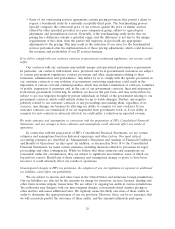HP 2010 Annual Report Download - page 25
Download and view the complete annual report
Please find page 25 of the 2010 HP annual report below. You can navigate through the pages in the report by either clicking on the pages listed below, or by using the keyword search tool below to find specific information within the annual report.If we cannot continue to develop, manufacture and market products and services that meet customer
requirements for innovation and quality, our revenue and gross margin may suffer.
The process of developing new high technology products and services and enhancing existing
products and services is complex, costly and uncertain, and any failure by us to anticipate customers’
changing needs and emerging technological trends accurately could significantly harm our market share
and results of operations. For example, we must successfully address the increasing market demand for
mobile computing devices in a variety of form factors that provide a compelling user experience. We
must also attract and retain developers to ensure the continued availability and development of
appealing and innovative software applications for our mobile computing devices. In addition, we are
transitioning to an environment characterized by cloud-based computing and software being delivered
as a service, and we must continue to successfully develop and deploy cloud-based solutions for our
customers. We must make long-term investments, develop or obtain appropriate intellectual property
and commit significant resources before knowing whether our predictions will accurately reflect
customer demand for our products and services. After we develop a product, we must be able to
manufacture appropriate volumes quickly and at low costs. To accomplish this, we must accurately
forecast volumes, mixes of products and configurations that meet customer requirements, and we may
not succeed at doing so at all or within a given product’s life cycle. Any delay in the development,
production or marketing of a new product could result in us not being among the first to market, which
could further harm our competitive position.
In the course of conducting our business, we must adequately address quality issues associated with
our products and services, including defects in our engineering, design and manufacturing processes, as
well as defects in third-party components included in our products. In order to address quality issues,
we work extensively with our customers and suppliers and engage in product testing to determine the
cause of the problem and to determine appropriate solutions. However, we may have limited ability to
control quality issues, particularly with respect to faulty components manufactured by third parties. If
we are unable to determine the cause, find an appropriate solution or offer a temporary fix (or
‘‘patch’’), we may delay shipment to customers, which would delay revenue recognition and could
adversely affect our revenue and reported results. Finding solutions to quality issues can be expensive
and may result in additional warranty, replacement and other costs, adversely affecting our profits. If
new or existing customers have difficulty operating our products, our operating margins could be
adversely affected, and we could face possible claims if we fail to meet our customers’ expectations. In
addition, quality issues can impair our relationships with new or existing customers and adversely affect
our brand and reputation, which could adversely affect our operating results.
Economic weakness and uncertainty could adversely affect our revenue, gross margin and expenses.
Our revenue and gross margin depend significantly on worldwide economic conditions and the
demand for computing and imaging products and services in the markets in which we compete.
Economic weakness and uncertainty have resulted, and may result in the future, in decreased revenue,
gross margin, earnings or growth rates and difficulty managing inventory levels. Sustained uncertainty
about current global economic conditions may adversely affect demand for our products and services.
Economic weakness and uncertainty also make it more difficult for us to make accurate forecasts of
revenue, gross margin and expenses.
We also have experienced, and may experience in the future, gross margin declines in certain
businesses, reflecting the effect of items such as competitive pricing pressures, inventory write downs
and increases in component and manufacturing costs resulting from higher labor and material costs
borne by our manufacturers and suppliers that, as a result of competitive pricing pressures or other
factors, we are unable to pass on to our customers. In addition, our business may be disrupted if we
are unable to obtain equipment, parts and components from our suppliers—and our suppliers from
their suppliers—due to the insolvency of key suppliers or the inability of key suppliers to obtain credit.
17
























